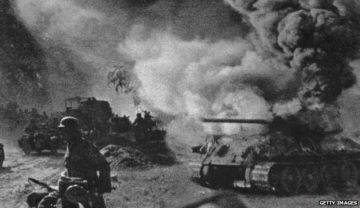by John Allen Paulos
 Lanchester’s square law was formulated during World War I and has been taught in the military ever since. It is marginally relevant to the war in Ukraine, particularly the balance between the quantity and quality of the two armies’ weapon systems.
Lanchester’s square law was formulated during World War I and has been taught in the military ever since. It is marginally relevant to the war in Ukraine, particularly the balance between the quantity and quality of the two armies’ weapon systems.
Although more accurately expressed in terms of differential equations, Lanchester’s square law can be roughly paraphrased as follows: “The strength of a military unit – planes, artillery, tanks, or just soldiers with rifles – is proportional not to the size of the unit, but to the square of its size.”
Let me illustrate this with a schematic conflict between two armies, one denoted QN (for numerical or quantitative) and the other QT (for technological or qualitative), each of which has 500 pieces of artillery. (The exposition is abstract, the numbers used are arbitrary, and QN and QT are not to be understood as Russia and Ukraine.)
Further assume that the two armies’ artilleries are more or less equivalent in effectiveness and are capable of destroying each other at a rate of, say, 9% per month. This assumption suggests that after one month each side will have 91% of what it had the month before. Neither side has an advantage, but let’s alter the balance of power in a way similar to an example put forward by Derrick Niederman and David Boyum in their book, What the Numbers Say.
Specifically, let’s see what happens if we assume that army QN can increase its artillery to 1,500 pieces, 3 times as many as army QT has?
There are two consequences. One is that each of QT’s artillery pieces will receive 3 times as much fire from QN’s artillery as before because QN now has three times as many guns as QT. Because of this QT will lose artillery at a rate of 27% (3 x 9%) per month. The other consequence is that each piece of QN’s artillery will receive 1/3 as much fire from QT’s artillery as before because QT now has 1/3 as many guns as QN. Because of this QN will lose artillery at a rate of 3% (1/3 x 9%) per month.
Lanchester’s square law in this case says that tripling the number of pieces of army QN’s artillery leads to a nine‑fold advantage (a 27% loss rate for QT versus a 3% loss rate for QN) in its relative effectiveness.
But army QT might be able to counter QN’s numerical superiority with better technology.
So let’s assume that army QT does so by upgrading its 500 pieces of artillery to make them each 9 times as accurate as QN’s 1,500 pieces of artillery. If QT is able to upgrade its artillery to this substantial degree, its rate of destroying QN’s artillery (if QN has an equal number of pieces) will no longer be 9% per month, but 81% (9 x 9%). But if we’re still assuming that QN has three times as many pieces of artillery, QT destroys only 27% (1/3 x 81%) of QN’s artillery each month.
Moreover, the rate at which QN’s more numerous artillery takes out QT’s artillery remains the same as calculated above at 27% per month as well. Thus, per Lanchester’s square law, it takes a nine-fold increase in QT’s quality to make up for a three-fold increase in QN’s quantity. In general, it takes an N‑squared‑fold increase in quality to make up for an N‑fold increase in quantity.
If the military units under discussion have drones, cruise missiles, and the like, this comparison breaks down a bit and Lanchester isn’t as relevant. However, with tanks and artillery it does come into play, and a sufficient degree of qualitative superiority can even the battlefield against a larger army.
When we get down to the level of individual soldiers with rifles fighting, the balance becomes unclear. Lanchester suggests that soldiers’ smaller degree of superiority (maybe 50% more effective, say, rather than 3 times as effective) may not always make up for the opponent’s numerical advantage.
Of course, this analysis is necessarily wildly simplistic and ignores many imponderable factors. As in Ukraine, much depends on whether or not an army has the morale and motivation to fight. Replenishing supplies and other dynamic aspects of the war are also crucial factors. Nevertheless, Lanchester’s square law provides a nice starting point when trying to assess the balance between weapons’ quantity and quality.
***
John Allen Paulos is a Professor of Mathematics at Temple University and the author of A Mathematician Reads the Newspaper, Innumeracy, and a forthcoming book, titled Who’s Counting –Uniting Numbers and Narratives with Stories from Pop Culture, Puzzles, Politics, and More
